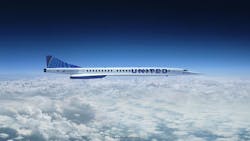Commercial passenger aircraft and avionics being developed to adapt to environmentally friendly fuels
WASHINGTON – The future of air travel looks to be faster and more environmentally friendly as the industry looks to balance consumer demand alongside "green" goals. Avionics to support environmentally friendly aircraft is in development.
Airlines for America (A4A) in Washington, the industry trade organization representing the leading U.S. airlines, announced the commitment of its member carriers to work across the aviation industry and with government leaders in a partnership to achieve net-zero carbon emissions by their aircraft and avionics by 2050. Likewise, Europe's aviation sector has announced the same goal, which they call "Destination 2050."
A4A members include Alaska Airlines, American Airlines, Atlas Air, Delta Air Lines, FedEx, Hawaiian Airlines, JetBlue Airways, Southwest Airlines, United Airlines, and UPS. Air Canada is an associate member.
A4A carriers pledged to work toward an expansion of the production and deployment of commercially viable sustainable aviation fuel (SAF) to make 2 billion gallons of SAF available to U.S. passenger aircraft operators in 2030.
This spring, the French foursome of Air France-KLM, Total, Groupe ADP, and Airbus joined forces on the first long-haul flight powered by SAF.
The SAF biofuel on this flight came from waste and residue from used cooking oil, which was processed at the La Mède biorefinery in southern France and at the Oudalle factory near Le Havre, France, without using any virgin plant-based oil.
French legislation calls for aircraft to use at least 1 percent SAF by 2022 for all flights originating in France, ahead of a plan to ramp up gradually to 2 percent by 2025 and 5 percent by 2030.
Cleaner-burning jet fuels made from sustainable sources can produce 50 to 70 percent fewer ice crystal contrails at cruising altitude to reduce aviation's impact on the environment, according to research by NASA and the German Aerospace Center (DLR).
Related: Think twice about avoiding that window seat: a look aboard the Boeing 787 Dreamliner
"We know that contrail formation from jet exhaust has a larger, more immediate impact on climate than carbon dioxide emissions," says Richard Moore, a scientist at the Langley Research Center in Langley, Va. "This research shows we have an opportunity using alternative fuels to make immediate changes that could help the planet."
This spring, officials from Alaska Airlines and SkyNRG Americas pledged to increase investment in SAF.
SkyNRG Americas initially will focus on developing dedicated SAF production facilities to supply Western U.S. airports. These facilities will use commercially available technologies that enable the use of municipal solid waste and other waste-based inputs as feedstocks, as well as incorporating green hydrogen and renewable energy for minimizing carbon intensity.
In June, GKN Aerospace in Redditch, England, announced a Swedish national collaboration program called H2JET, with the goal of fueling three engine subsystems for H2 medium-range civil aircraft. The two-year project sees GKN Aerospace collaborate with the Swedish Energy Agency, Chalmers University of Technology, Lund University, KTH Royal Institute of Technology, University West, Research institutes of Sweden (RISE), and Oxeon.
Related: Next-generation satellite-based air navigation system to save on fuel costs
Hydrogen is expected to play a role in the decarbonization strategy of aviation as it can power aircraft efficiently, leaving water as the only by-product. It generates power either by direct combustion -- the focus of H2JET -- or by generating onboard electrical power with a fuel cell.
Experts from Bye Aerospace in Englewood, Colo., found launch customers for their all-electric, seven-seat aircraft. Jet It and JetClub announced their agreement with Bye Aerospace this summer.
Jet It and JetClub, sister companies operating in North America and Europe respectively, have signed a purchase agreement for a fleet of eFlyer 800 and four eFlyer 4 aircraft. Jet It will operate the first fleet of electric aircraft in North America.
Set for operation by 2025, the eFlyer seats as many as seven passengers and one or two pilots. The eFlyer has cruise speeds of 320 knots and a ceiling of 35,000 feet.
On 18 June, Chicago-based Boeing announced its 737-10, the largest airplane in the 737 MAX family, completed a successful first flight. The 737-10 can carry as many as 230 passengers. It also incorporates environmental improvements, cutting carbon emissions by 14 percent and reducing noise by 50 percent compared to today's next-generation 737s.
Leiden, Netherlands-based Airbus in July delivered the first A350 from the company's widebody completion and delivery center in Tianjin, China. The center was inaugurated in September 2017 to produce A330s.
For nearly 20 years, the speed of commercial air travel has remained below the speed of sound, which is 761.2 miles per hour. Boeing claimed to be the fastest commercial jet in its 747-8I, which has a top speed of Mach 0.86 -- or nearly 660 miles per hour -- when the vaunted Concorde was retired in 2003. The Aérospatiale/BAC Concorde flew over twice the speed of sound.
Related: Avionics enter the 5th generation
In June, United Airlines, based in Chicago, announced plans to go supersonic later this decade with a purchased 15 Boom Overture aircraft.
The Overture, expected to roll out in 2025 with first flight planned for 2026 and delivery planned for 2029, will seat 65 to 88 passengers. At 205 feet in length, the Overture will cruise at 60,000 feet at Mach 1.7 and has a range of 4,250 nautical miles.
United also holds an option to purchase an additional 35 aircraft. The companies will work together on meeting operation requirements before delivery. Once operational, Overture is expected to be the first large commercial aircraft to be optimized to run on 100 percent SAF on day-one.
About the Author
Jamie Whitney
Senior Editor
Jamie Whitney joined the staff of Military & Aerospace Electronics in 2018 and oversees editorial content and produces news and features for Military & Aerospace Electronics, attends industry events, produces Webcasts, and oversees print production of Military & Aerospace Electronics.
